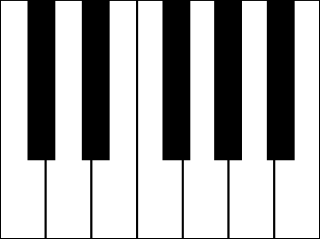
In Western musical notation, a key signature is a set of sharp, flat, or rarely, natural symbols placed on the staff at the beginning of a section of music. The initial key signature in a piece is placed immediately after the clef at the beginning of the first line. If the piece contains a section in a different key, the new key signature is placed at the beginning of that section.
In musical notation, an accidental is a symbol that indicates an alteration of a given pitch. The most common accidentals are the flat and the sharp, which represent alterations of a semitone, and the natural, which cancels a sharp or flat. Accidentals alter the pitch of individual scale tones in a given key signature; the sharps or flats in the key signature itself are not considered accidentals.

The chromatic scale is a set of twelve pitches used in tonal music, with notes separated by the interval of a semitone. Chromatic instruments, such as the piano, are made to produce the chromatic scale, while other instruments capable of continuously variable pitch, such as the trombone and violin, can also produce microtones, or notes between those available on a piano.
In music, two written notes have enharmonic equivalence if they produce the same pitch but are notated differently. Similarly, written intervals, chords, or key signatures are considered enharmonic if they represent identical pitches that are notated differently. The term derives from Latin enharmonicus, in turn from Late Latin enarmonius, from Ancient Greek ἐναρμόνιος, from ἐν ('in') and ἁρμονία ('harmony').
In music, in English sharp – eqv. dièse or diesis – means higher in pitch. The sharp symbol, ♯, indicates that the note to which the symbol is applied is played one semitone higher. The opposite of sharp is flat, indicating a lowering of pitch. The ♯ symbol derives from a square form of the letter b.
In music, flat means lower in pitch. It may either be used generically, meaning any lowering of pitch, or refer to a particular size: lowering pitch by a chromatic semitone. A flat is the opposite of a sharp which raises pitch by the same amount that a flat lowers it.

In music theory, the circle of fifths is a way of organizing pitches as a sequence of perfect fifths. Starting on a C, and using the standard system of tuning for Western music, the sequence is: C, G, D, A, E, B, F♯, C♯, G♯, D♯, A♯, E♯ (F), C. This order places the most closely related key signatures adjacent to one another. It is usually illustrated in the form of a circle.
B, also known as Si, Ti, or, in some European countries, H, is the seventh note and the twelfth semitone of the fixed-Do solfège. Its enharmonic equivalents are C♭ (C-flat) and A.
C-flat major is a major scale based on C♭, consisting of the pitches C♭, D♭, E♭, F♭, G♭, A♭, and B♭. Its key signature has seven flats. Its relative minor is A-flat minor. Its parallel minor, C-flat minor, is usually replaced by B minor, since C-flat minor's three double-flats make it impractical to use. The direct enharmonic equivalent of C-flat major is B major, a key signature with five sharps.
F-sharp major is a major scale based on F♯, consisting of the pitches F♯, G♯, A♯, B, C♯, D♯, and E♯. Its key signature has six sharps.
G-sharp minor is a minor scale based on G♯, consisting of the pitches G♯, A♯, B, C♯, D♯, E, and F♯. Its key signature has five sharps.
D-sharp minor is a minor scale based on D♯, consisting of the pitches D♯, E♯, F♯, G♯, A♯, B, and C♯. Its key signature has six sharps.
F minor is a minor scale based on F, consisting of the pitches F, G, A♭, B♭, C, D♭, and E♭. Its key signature consists of four flats. Its relative major is A-flat major and its parallel major is F major. Its enharmonic equivalent, E-sharp minor, has six sharps and the double sharp F, which makes it impractical to use.

In music, 53 equal temperament, called 53 TET, 53 EDO, or 53 ET, is the tempered scale derived by dividing the octave into 53 equal steps. Each step represents a frequency ratio of 21⁄53, or 22.6415 cents, an interval sometimes called the Holdrian comma.
In music, 22 equal temperament, called 22-TET, 22-EDO, or 22-ET, is the tempered scale derived by dividing the octave into 22 equal steps. Each step represents a frequency ratio of 22√2, or 54.55 cents.
D-flat minor is a theoretical key based on D♭, consisting of the pitches D♭, E♭, F♭, G♭, A♭, B, and C♭. Its key signature has one double flat and six flats. Its relative major is F-flat major, which is usually replaced by E major. Its parallel major is D-flat major. Its direct enharmonic equivalent, C-sharp minor, is normally used.
G-sharp major is a theoretical key based on the musical note G♯, consisting of the pitches G♯, A♯, B♯, C♯, D♯, E♯, and F. Its key signature has one double sharp and six sharps.
F is a musical note, the fourth above C or fifth below C. It is the fourth note and the sixth semitone of the solfège. It is also known as fa in fixed-do solfège. It has enharmonic equivalents of E♯ (E-sharp) and G, amongst others.
F-flat major is a theoretical key based on F♭, consisting of the pitches F♭, G♭, A♭, B double flat, C♭, D♭, and E♭. Its key signature has one double flat and six flats.
In modern Western music notation, a natural (♮) is a musical symbol that cancels a previous sharp or flat on a note in the written music. The sharp or flat may be from a key signature or an accidental. The natural indicates that the note is at its unaltered pitch.
![]() ), or double-sharps (
), or double-sharps ( ![]() ).
).![]() ). In 12-tone equal temperament, the standard tuning of Western music, the key of G♯ major is enharmonically equivalent to A♭ major (with four flats). In the absence of other factors, this key would generally be notated as A♭.
). In 12-tone equal temperament, the standard tuning of Western music, the key of G♯ major is enharmonically equivalent to A♭ major (with four flats). In the absence of other factors, this key would generally be notated as A♭.








